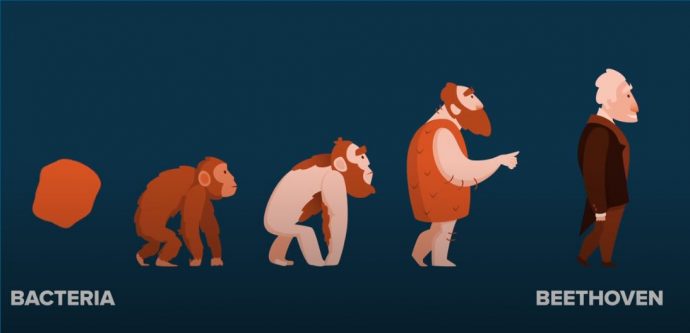I love it — Bacteria to Beethoven — here is a new video from Prager University (for more on the topic click here):
For a century Charles Darwin’s theory of evolution has been as unquestioned as Newton’s theory of gravity. But science never stops asking questions. Or at least it’s not supposed to. Stephen Meyer, Senior Fellow at the Discovery Institute, takes up the challenge in this video. Are there questions about the origins of life that Darwinism can’t answer?
Click here to watch the video.
From the transcript:
Evolution.
You learned about it in high school.
It goes like this: Life started out with very simple forms and then gradually, over hundreds of millions of years, morphed into all the forms we see today. Bacteria to Beethoven. Not a straight line, of course…but that’s roughly how it went.
This was the theory proposed by Charles Darwin in 1859, and, with some modification, it has been embraced as unassailable by the science community over the last century. As evolutionary biologist Richard Dawkins says, “If you meet somebody who claims not to believe in evolution, that person is either ignorant, stupid or insane.”
But is that right? Are there no scientific reasons to doubt the evolutionary account of life’s origins?
In November 2016, I attended a conference in London convened by some of the world’s leading evolutionary biologists. The purpose: to address growing doubts about the modern version of Darwin’s theory.
Let’s look at just two scientific reasons to doubt this theory.
First, the Cambrian Explosion. A weird and wonderful thing happened 530 million years ago: A whole bunch of major groups of animals—what scientists call the “phyla”—appeared abruptly within a geologically short window of time—about ten million years.
These novel animal forms—exhibiting proto-types of most animal body designs we see today—emerged in the fossil record without evidence of earlier ancestors.
Did you catch that? A huge number of diverse animals appeared, with no discernible antecedents.
So where did they come from?
This question really bothered Darwin. And he acknowledged that he could give it “no satisfactory answer.” Nor can scientists today.
The renowned biologist Eugene Koonin, of the National Center for Biotechnology Information, describes the abrupt appearance of the Cambrian animals and other organisms such as dinosaurs, birds, flowering plants and mammals as a pattern of “biological Big Bangs.”
So what caused all these new forms of life to arise? That question leads to a second big doubt: the DNA enigma.
Read more: PragerU

